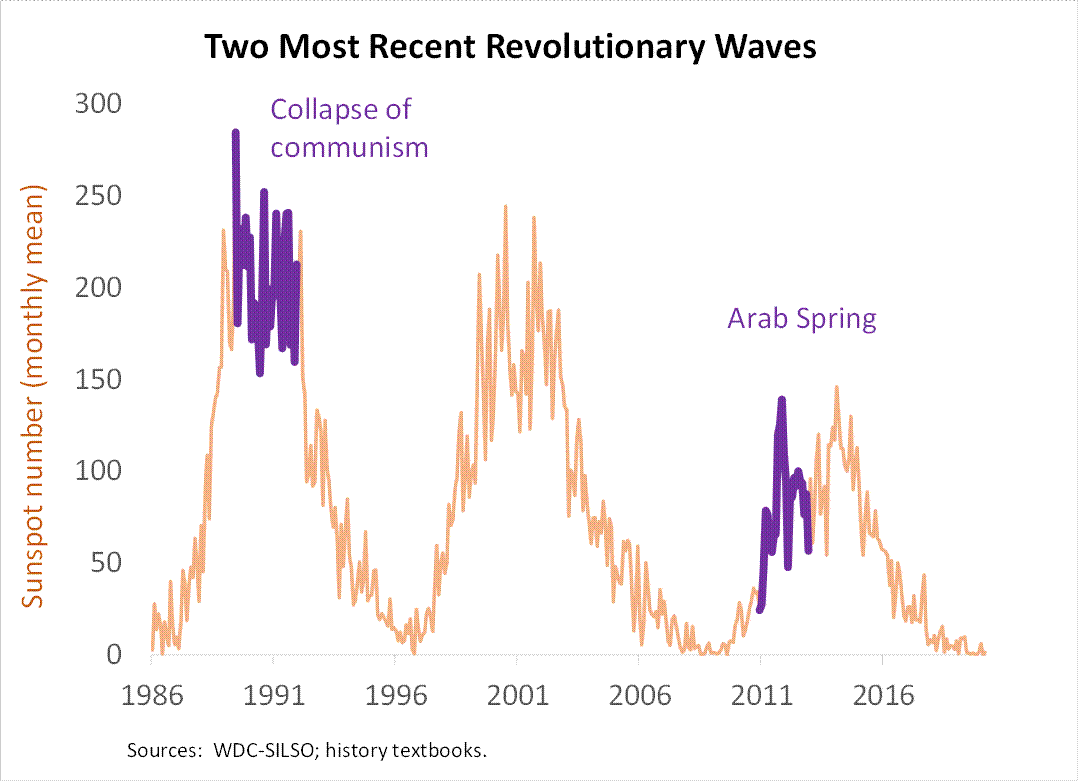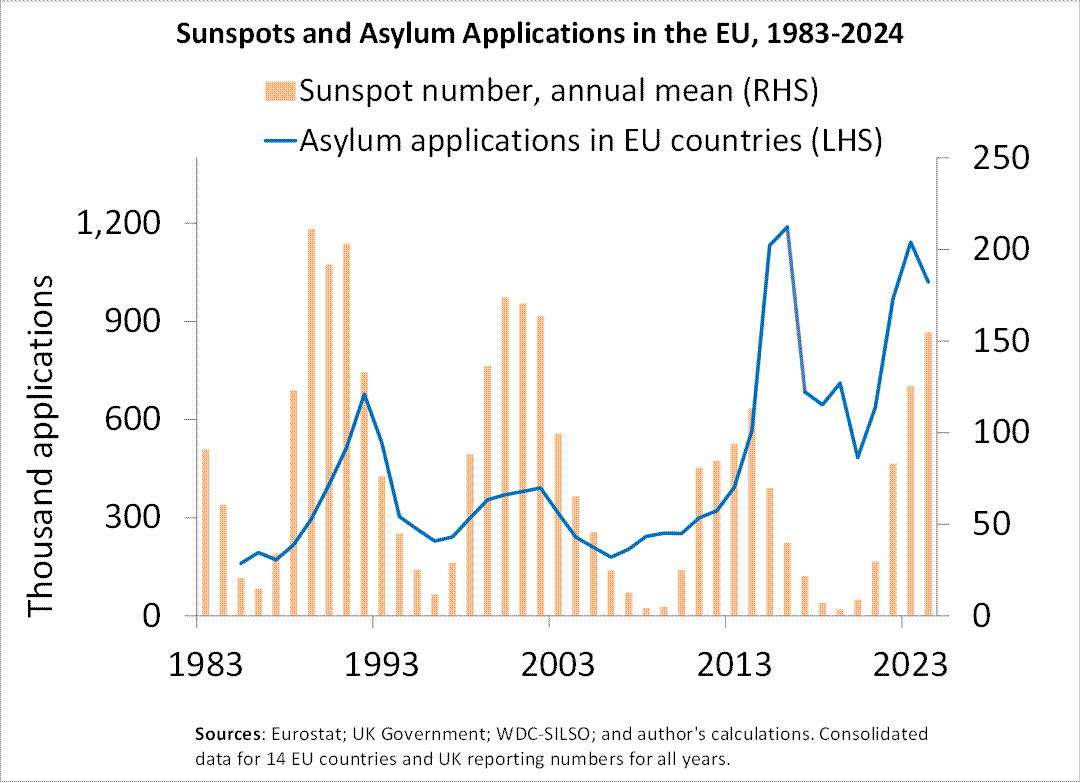Solar Activity and
Perturbations in Economy and Society
Theoretical claims
|
|
William
Stanley Jevons (1835-1882), English
economist and logician: Major “commercial crises” occur with intervals broadly
matching solar cycle length, a “beautiful coincidence”. Read
more |
|
|
Alexander
Chizhevsky (1897-1964), Russian
interdisciplinary scientist: Up to 60 percent of revolutions and other “most important historical events involving large numbers of people” occur in three years around and after cyclical maximums of solar activity. Read more |
Solar Activity and Economic Recessions
In the US, where the longest series
of consistent recession dates is available, during the entire XX century and in
the early XXI century each cyclical maximum of solar activity overlapped
closely with a recession. This striking pattern worked for over 100 years until
the US economy did not go into recession after the maximum of the weak solar
cycle 24 in April 2014. Are we going to see a US recession after the maximum of
solar cycle 25 in October 2024?

Solar Activity and Revolutions
Two most important revolutionary
events of the XX century – the Russian revolution of 1917 that brought
communists to power and the USSR collapse in 1991 – occurred in the years of
maximum solar activity.

|
|
Years |
Events |
|
|
1905-07 |
Revolution
of 1905-07 in the Russian Empire |
|
|
1917 1918 |
February
Revolution, Great October Socialist Revolution in Russia Revolutions
in Germany, Hungary, collapse of Austro-Hungarian Empire |
|
|
1936 |
Revolution
in Spain |
|
|
1946-49 |
Conversion
of Eastern Europe to socialism |
|
|
1956 |
Hungarian
Revolution, Poznań protests in Poland |
|
|
1968 1970 |
“Prague
Spring” in Czechoslovakia Protests
in Poland |
|
|
1980-81 |
Polish
crisis, emergence of “Solidarity”, martial law in Poland |
|
|
1989 1991 |
Fall
of Berlin Wall, collapse of communism in Eastern Europe Collapse
of Soviet Union and Yugoslavia |
Out of 21 solar maximums in
1785-2014, 16 associated with most important revolutions that shaped the human
history.

|
|
Years |
Events |
|
|
1789 |
Great
French Revolution |
|
|
1830 |
Revolutions
in Europe (France, Poland, Germany, Italy, Greece) |
|
|
1848 |
Revolutions
in Europe (Italy, France, Germany, Austria, etc.) |
|
|
1861 |
Secession
by the 13 southern US states that formed the C.S.A. |
|
|
1871 |
Uprising
in Paris, “Paris Commune” |
|
|
1905-07 |
Revolution
of 1905-07 in the Russian Empire |
|
|
1917 1918 |
February
Revolution, Great October Socialist Revolution in Russia Revolutions
in Germany and Hungary, collapse of Austro-Hungarian Empire |
|
|
1927 |
Revolution
in Mexico |
|
|
1936 |
Revolution
in Spain |
|
|
1947 1949 |
Independence
and violent partition of India Revolution
in China |
|
|
1957-59 1960 |
Revolution
in Cuba “Year
of Africa”: 17 countries gained independence |
|
|
1968 |
Student
protests, general strikes in Europe and in Mexico |
|
|
1979 |
Islamic
Revolution in Iran |
|
|
1989 1991 |
Fall
of Berlin Wall, collapse of communism in Eastern Europe Collapse
of Soviet Union and Yugoslavia |
|
|
2001 |
Rise
of al-Qaeda, terrorist attack on the U.S. on September 11 |
|
|
2010-12 2013-14 |
“Arab
Spring”: Revolutions in Egypt, Libya, Syria, Yemen, Tunisia Revolution
in Ukraine |
Two most recent
revolutionary waves – the collapse of communism in 1989-91 and the
chain of revolutions in the Arab countries dubbed the “Arab Spring” in 2010-12
– overlapped with periods of elevated solar activity.

Solar Activity and Migration
Refugee inflows in the EU countries
followed solar cycle pattern in 1985-2024.

Are these facts an interesting
coincidence or part of a broad pattern?
Research papers and presentations
Extraordinary
Economic and Social Events Associated with the Solar Cycle Maximum (2025)
The currently unfolding solar cycle 25 reached its maximum
on or about October 2024. According to long-standing theoretical claims,
cyclical maximums of solar activity could be associated with economic
recessions (W.S.Jevons), revolutions and migration (A.L.Chizhevsky). And indeed, several of such extraordinary
events have already occurred recently. These include revolutions in Bangladesh
(2024), government collapse in Syria (2024), Hamas terrorist attack on Israel
(2023), and student protests in the US and Europe against the war in Palestine
(2024). Meanwhile, migrant influx overwhelmed the US and Western Europe. Are we
going to see more of the extraordinary events typically associated with the
solar maximums, such as revolutions in a few more countries colliding in a
revolutionary wave like the Arab Spring of 2010-12 or collapse of Communism in
1989-91? Or economic recessions in the US and other advanced economies leading
to a global economic slowdown?
Also available from RePEc, ResearchGate
Shifting Pattern of
Extraordinary Economic and Social Events in Relation to the Solar Cycle
(2020)
Most notable claims linking events on Earth with solar
cycle phases relate to solar maximums. Cyclical maximums of solar activity
could be associated with economic recessions (W.S.Jevons)
or revolutions (A.L.Chizhevsky). However, both the
diminishing magnitude of solar cycles and the recent crisis events warrant
closer attention to solar minimums. The ongoing global economic and financial
crisis—caused by the “great lockdown” response to the new COVID-19 coronavirus
pandemic—coincided with cyclical minimum of solar activity, as did the previous
Global Financial Crisis of 2007-09. And before that, Asian crisis of 1997-98
began shortly after solar minimum. These events point to the new emerging
pattern of global economic and financial crises coinciding with cyclical
minimums of solar activity.
Also available from RePEc, ResearchGate
Can Solar Activity Influence the
Occurrence of Economic Recessions? (2015)
This paper revisits evidence of solar activity influence on
economy. We examine whether economic recessions occur more often in the years
around and after solar maximums. This research strand dates back to late XIX
century writings of famous British economist William Stanley Jevons, who
claimed that “commercial crises” occur with periodicity matching solar cycle
length. Quite surprisingly, our results suggest that the hypothesis linking
solar maximums and recessions is well anchored in data and cannot be easily
rejected.
Also available from RePEc, ResearchGate
Sunspots, unemployment, and recessions, or Can the solar
activity cycle shape the business cycle? (2012)
Over the last 77 years (from 1935), all 7 cyclical maximums of the solar activity overlapped closely with the US recessions, thus predicting (or triggering?) 8 out of 13 recessions officially identified by NBER (including one “double-deep” recession). Over the last 64 years (from 1948), all 6 maximums of the solar activity were preceded by minimums of the US unemployment rate, and the spikes in the unemployment rate followed with lags of 2-3 years. On the world scale, over the last 44 years (for which the data is available), all 4 maximums of the solar activity overlapped with minimums of the unemployment rate in the G7 countries, followed by its spikes within 2-3 years. From 1965, when consistent recession dating is available for all G7 countries, nearly 3/5 of the recessions started in the 3 years around and after the sunspot maximums. Was it a mere coincidence or a part of a broader pattern? This paper explores the correlation between the solar activity cycles (as measured by the number of sunspots on the sun surface) and the timing of recessions in the US and other economies. It finds out that the probability of recessions in G7 countries greatly increased around and after the solar maximums, suggesting that they can cause deterioration in business conditions and trigger recessions. This opens new approach for projecting recessions, which can be applied and tested with regard to the next solar maximum in 2013.
Also available from RePEc, ResearchGate
Can the Solar Activity
Influence the Occurrence of Revolutions and Economic Recessions? (2024)
Can Solar Activity Influence the
Occurrence of Economic Recessions? (2016)
Can solar activity influence the occurrence of recessions? (2015)
Sunspots, Unemployment, and Recessions, or Can the
Solar Activity Cycle Cause the Business Cycle?
(2012)
Further research and literature references
Last update: February 2025

